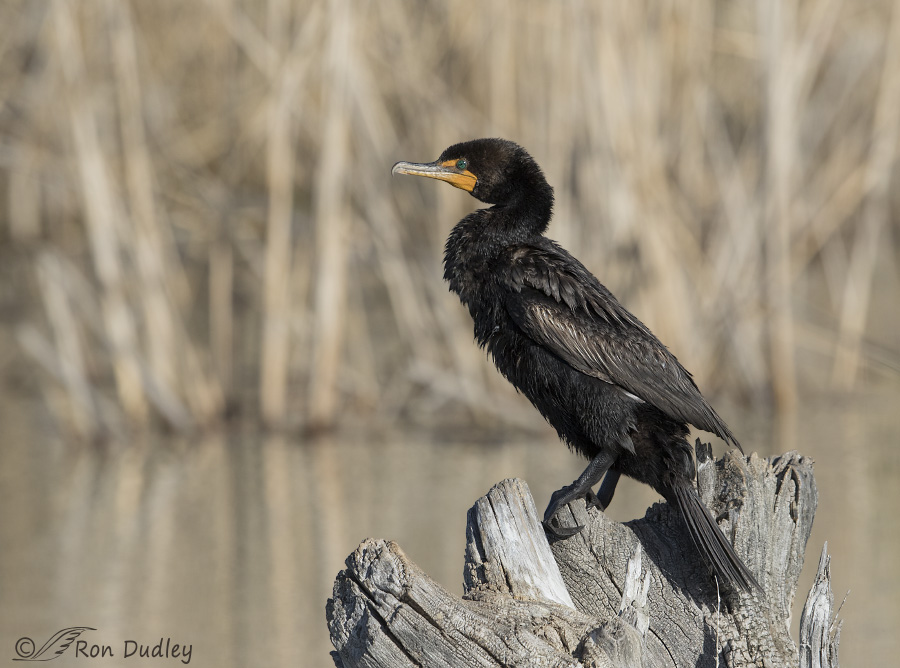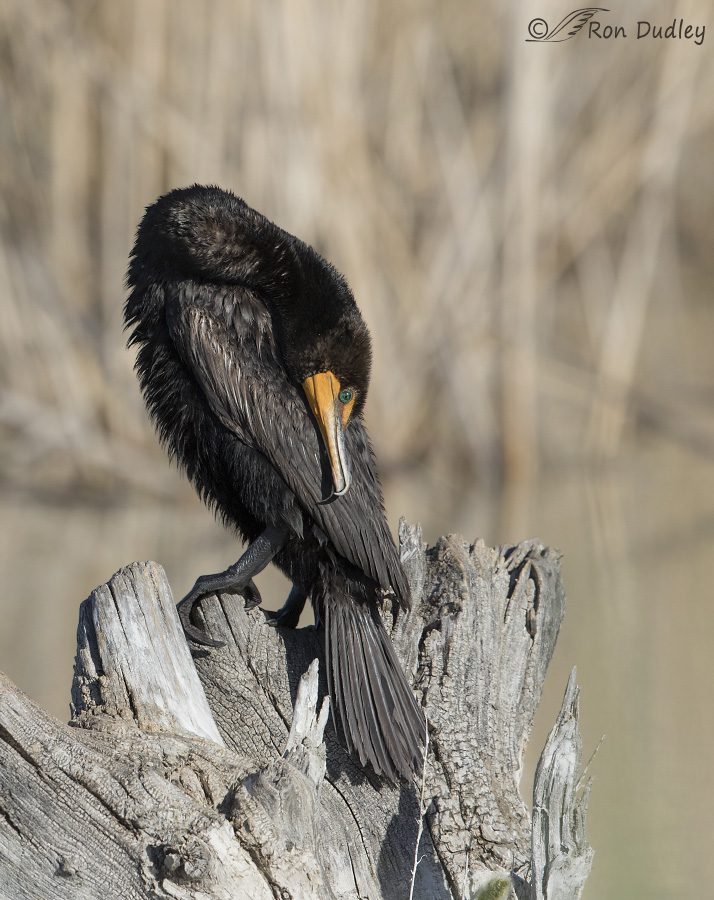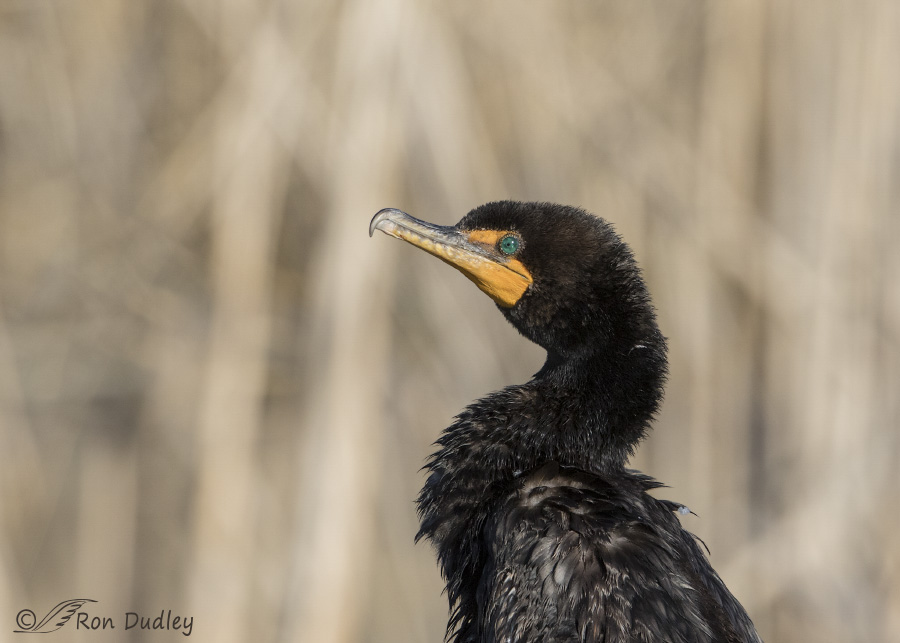I should aim my lens at cormorants more often than I do. Both their physical appearance and their behaviors seem almost prehistoric and that piques my interest. Part of the reason I seldom post images of them is because their very dark color makes them difficult to photograph well, especially in flight.

1/4000, f/8, ISO 500, Canon 7D Mark II, Canon EF 500mm f/4L IS II USM, not baited, set up or called in
But last month at Bear River MBR this Double-crested Cormorant posed nicely for me in good light and on an interesting perch. It was a cool morning and this bird was actually shivering as it attempted to warm up in the morning sun. I fully expected it to spread its wings in the sun to dry them (a behavior extremely common to the species) but it never did.
It’s my preference to photograph cormorants when they’re out of the water like this because when they’re swimming they’re typically so low in the water that very little of their body can be seen.

1/3200, f/8, ISO 500, Canon 7D Mark II, Canon EF 500mm f/4L IS II USM, not baited, set up or called in
These birds spend an inordinate amount of time and effort preening. When oiling their feathers they use both their bill and the back of their head to spread preen-gland secretions (which is what this bird is doing). They also spread the oil on their legs and feet. There has been at least one documented instance of cormorants using molted secondary feathers as a brush-like tool to spread preen gland secretions over the wings.

1/2000, f/7.1, ISO 500, Canon 7D Mark II, Canon EF 500mm f/4L IS II USM + 1.4 tc, not baited, set up or called in
When they’re close enough for us to see them well their striking aquamarine/turquoise eyes sparkle like jewels. Greenish eyes are uncommon in nature so this is a feature that really stands out.
Largely because of their fish-eating habits cormorants have been viewed negatively by humans throughout history. Since about 1975 the rapidly diminishing numbers of Double-crested Cormorants have rebounded nicely due to the ban on DDT and other factors. But as a result of perceived threats to human recreational and commercial fisheries the USFWS has made substantial federal policy changes that allow “culling” of cormorants by state, federal and tribal entities in the US.
Under the new rules individuals (in certain circumstances) and states are allowed to kill a total of 160,000 cormorants each year. Methods used include shooting, destroying nests and oiling eggs (which suffocates the growing embryos – the adults continue to incubate the lifeless eggs which prevents them from laying another clutch).
A description from the Seattle Times describing cormorant culling activities of federal agents on East Island, Columbia River Estuary, says it all:
- “Federal agents have stalked this tiny uninhabited island with night-vision goggles and silencers, blasting birds on the nest. They have oiled more than 5,000 eggs to suffocate the embryos within. And now, they have taken to the water, firing at double-crested cormorants with shotguns under a federal program intended to boost juvenile salmon and steelhead survival.”
And typical of human blundering it appears that these efforts to save Columbia River/Snake River salmon and steelhead are misdirected. According to the project leader for the Columbia River Fisheries Program Office for the USFWS these cormorant cullings are “expected to have little or no effect” on salmon and steelhead production or on the abundance of returning adult fish. Other studies support his conclusions. The real culprit is all the dams on the river system.
It’s a convoluted web of politics, vested interests, ignorance and knee-jerk reactions to a complex problem – much too complex for thorough treatment here. But if you love birds and have the interest here’s a couple of links (Seattle Times, Natural History Magazine) that will likely get your blood boiling. Just as mine is.
Ron


Beautiful bird….sad circumstances. Thank you for sharing the information… Of all bird eyes, Cormorant eyes are the gems, to me! Anhingas do look similar and are found all along the Southeastern coast, Linda! What makes this cormorant “double crested”? Are there crest that are not showing?
More misguided human meddling. I was pleased to see some of these birds swimming in the canal near us last year, here in the Phoenix, AZ area.
I was pleased to see some of these birds swimming in the canal near us last year, here in the Phoenix, AZ area.
I’ve been following the efforts to cull on the west coast – and it makes me furious…




I understand your fury, Nicole. Completely.
I am so glad you captured this bird. We have had the DB Cormorant here, but unfortunately the Lake dried up. I never could get close enough for a good picture of them when they were at the lake. Such beautiful eyes!! I had no idea. Wonderful pictures Ron.
I think Dick summed it up pretty good. I have often wondered how man kind can be so intelligent in some areas, yet so ignorant in other areas. Not sure some of them will ever learn.
Our cormorants are generally pretty hard to get close to also, Jean. I understand that in some areas of the country some populations of them are fairly tame.
PS: Love the cormorants. And often marvel at their beauty and flexibility. Thank you.
Thanks, EC. Many think of cormorants as less than beautiful but I think they’re magnificent results of evolution.
Hiss and spit. And rather a lot of other phrases which are turning the air blue around here.
Our greed is a truly rotten reason to kill things. And a very common reason. All too often teamed with ignorance and/or stupidity.
Some days I despair.
I live in Salt lake City near a public golf course. It has a pond and I see plicans and cormorants there frequently. I feel fortunate to live in the middle of a city and have the oportunity to see wild birds. several years ago there was even a bald eagle in one of the trees nea my hous. I wonder if man will ever learn that knee jerk solutions to perceived problems are never the answer. Your pictures are a joy to see everyday. I’m so glad I found your blog.
Thank you, Betty. I’d glad you found it too.
Beautiful photos Ron. They have incredibly beautiful eyes. Silly me used to think that Wildlife Services was for the protection of wildlife. I recently found out how wrong I was. There was a nest of six owlets who were starving to death one by one. Before I called Wildlife Services I looked for and found a rescue who was willing to go get them. I called Wildlife Services and I was shocked when they refused to give the refuge permission to get them. I kept calling and calling and finally when there was only one baby left they let the refuge rescue her. She is becoming a beautiful Barn Owl. The more I read about Wildlife Services and what they do the more disgusted I get. So there really isn’t anyone to help wildlife in trouble. Sad.
That’s an awful story, Debbie.
Debbie that whole situation was beyond crazy (assuming we’re talking about the same Texas nest)! I used to think that Cornell was a really cool, worthy-of-high-respect place. Not so much anymore. Even if we’re not talking about the same nest, that was just awful! I didn’t know you’d called Wildlife Services…I could have given you an earful on them!
Laura, yes it was the Texas Barn Owls. I hope no one has to witness something like that again.
Agreed Debbie! That was an awful situation.
Those are beautiful pics capturing their beauty. They tend to be good ‘models’ sitting for good periods of time. Ron, have you captured the Anhinga yet? I believe it’s only in Florida. It looks so close to the Cormorant. Linda
Nope, no Anhinga yet, Linda. And it’s not likely to happen since I’m determined to never fly again if at all possible…
Utah had a similar program for American White Pelicans in the 1930’s. The ugly topic keeps popping up as sport fisherman claim pelicans are eating too many fish in Utah and Idaho. Utah biologist are currently studding where Utah pelicans go and what they are eating.
I wish people could learn to share with our wild neighbors. You are going to get me started on one of my rants. Instead I will share a couple of links. that talk about pelican culling.
http://www.audubon.org/news/hunting-season-white-pelicans
http://www.thewildlifenews.com/2016/03/28/idaho-pelicans-in-the-crosshairs-again/
Ron on another note I have an old book, The Bird Life On the Great Salt Lake written by professor of Zoology at the U of U, William H Behle 1958. It is very interesting. It contains history, ecology and population trends of gull, White Pelicans, Double Crested Cormorants and Great Blue Herons along with Bear River Migratory Bird refuge into too. if you would like to barrow it sometime I would not object. Although the data is old I think you would find it interesting.
April, I remember that book and Dr. Behle! He was the original spark in my intense interest in birds when I took his Ornithology class at the U of U back in the late 60’s. He was and still is a legend in Utah ornithology. He came up with some real doozies as questions on his lab practical exams (including birds specimens with congenital deformities that we were supposed to identify in hand…).
I wish he were still there when I took classes at the U, he sounds like the kind of teacher I love learning from.
I’ve never known anyone who was so absolutely FOCUSED on birds!
Great shots as always.
Oh my, some of the same stuff they are doing here on Lake Champlain in VT.
Why? Because they compete for fish that Bass Fisherman pay money to catch. Really? I have always known there were many more species of fish in Champlain than Bass! There are other reasons given, but I have little patience with the thought process that humans are the center of the universe, and wildlife takes a back seat, or the far end of the bus before positive things happen in their favor.
I could rant on further, but thank you for allowing me to vent a tad!
Calling their line of reasoning a “thought process” is very generous, Dick. And venting can be good for the soul – it’s cathartic.
Instead of “thought process” how about “effing greed and stupidity” (OK. I’m no lady and too old to play that game)..,,
((((HUGS))) Patty! Yep, that works for me!
Dick Harlow, I’m right there with you! Nature balances itself if left alone. Humans are NOT the center of the Universe and I believe that way of thinking will be the end of us, sooner or later. It’s just a matter of how many other folks (species) we take with us. If we’d only listen, we have so much to learn from other species. That was one of the huge things I learned through falconry. The sad part is as our population grows, we’re pushing everybody else off this spinning rock. Would that something would come along to cull our numbers. OK, yes, I am a heretic
Thank you for such beautiful pictures of these gorgeous birds! Frankly, I don’t see how anyone with a conscience can work for the USFWS.
Obviously a conscience isn’t a prerequisite for the job…
Outstanding images. I’ve loved cormorants since I first encountered them. They’re spectacular birds. What a lovely way to start the day.
As for the rest, there’s just no end to human stupidity is there? As if we can control anything in Nature–what hubris! Another example in the Pacific Northwest is the rogue government agency named Wildlife Services spent countless dollars culling barred owls two years ago under the excuse to “save” the spotted owl. This year, they spent another wad of our national treasure to cull spotted owls. REALLY? And they don’t seem to know that barred and spotted owls are hybridizing themselves in the wild.
And you really don’t want to get me started talking about Wildlife Services. I literally turn red and smoke pours out of my ears.
I feel the same about Wildlife Services as you do, Laura. What a (deliberately) misleading name. I encountered one of those guys a couple of months ago near the Promontory Mountains. He was killing coyotes.
Maybe WDS would be more appropriate…”Wildlife Destruction Services”…or “Department of Environmental Sellout” (DES) or “Department of Environmental Pushovers”(DEP),or “Environmentally Pathetic Associates”. (EPA)… They all fit these days in my book…There are a few truly dedicated in the field, God bless them, but their appointed “superiors” are too often just uncaring, wimpy political hacks….
The thing that frightens me to the core is that even when I do education about these things, including the western land grab movement (that will soon be in a wild area near you!), I can’t get anyone to care, let alone ACT! I get very few comments, even with the most horrific examples of what they’re doing in secrecy. And if we don’t care and ACT, this will continue to happen. I can’t imagine how Americans are so mindless about what’s going on under their noses. I just don’t get it. This SHOULD be a major issue in politics–and yes, I know. You can tell when a politician is lying when their lips are moving. My only consolation now is that I’m old and I don’t have any children/grandchildren. But I still weep for the ongoing losses.
Ron, as you know, the reason why they’ve been so successful is that they operate under the cloak of secrecy–oddly under the USDA! They’ve GOT to go. What most people don’t get is that they’re working for private ranchers/landowners and we taxpayers are funding their work! Despicable!
All true, Laura. I also share your deep frustrations.
I’m glad you got and posted these photos. I’m a big fan of Cormorants, especially after meeting a Cape Cormorant up close and personal in Namibia a couple of years ago. That bird had tons of personality. And even though they are dark colored, they have absolutely beautiful feather patterns. This planet survived just fine with Cormorants for millennia, so it makes no sense that humans feel a need to restrict their population. If humans didn’t do things (like pollute water) that were hard on fish, I’m sure there would be plenty enough to go around for all. I’m going to skip your links because I know I’d be upset, and just don’t want to go there today.
Wow, a Cape Cormorant! I’m envious, Susan.
Makes me sick!!!! Beautiful bird!!! Too many idiots out there!!!
“Too many idiots out there”
Ya think?
Sounds exactly like what happens here in NY state, on Lake Ontario. There is an island where they breed and the same tactics are used. I love their green eyes.
Carol, they also do a lot of cormorant culling in southeast states where catfish and crayfish are heavily farmed.
.SICKENING!!! Another cruel, stupid, example of human bungling…beautiful images of a fascinating bird….love the gnarly, weathered wood perch….
I like that perch too, Patty. There’s very few trees on the refuge so it was nice to catch this bird on that old stump.
Beautiful shots, Ron! Those eyes are to die for! We humans sure can figure out convoluted ways to placate others and get our way.
We humans sure can figure out convoluted ways to placate others and get our way. 
Thanks, Judy. Yup, leave it to Homo sapiens to screw up the works.